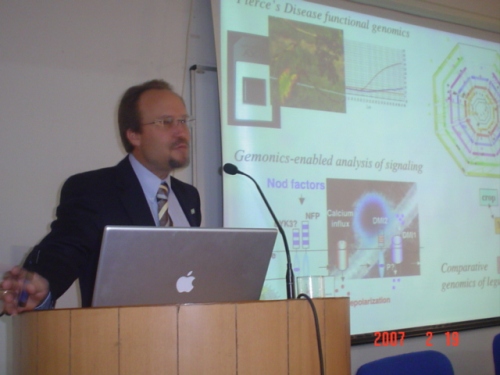19 Feb 2007|Noida | Amity University Campus, Sector-125, Noida
Lecture on Symbiosis by Dr. Douglas R. Cook, University of California
 Under the Amity Science & Technology Foundation (ASTF) Lecture Series, Dr. Douglas R. Cook, Director, CA&ES Genomics Facility, Professor, Department of Plant Pathology, University of California, USA presented a descriptive lecture on "Symbiosis".
Under the Amity Science & Technology Foundation (ASTF) Lecture Series, Dr. Douglas R. Cook, Director, CA&ES Genomics Facility, Professor, Department of Plant Pathology, University of California, USA presented a descriptive lecture on "Symbiosis". The lecture was mainly focused on the researches done by the speaker on symbiotic nitrogen fixation by legume plants such as Pigeon pea, Cow-pea, Chick-pea, Mung bean etc. The speaker discussed about the mechanism of root nodule formation by Rhizobium and the energy requirements during the nitrogen fixation.
The atmosphere contains nitrogen in its molecular form dinitrogen, which is converted into the biological form of nitrogen i.e. ammonia by the root nodule bacteria at the expense of energy. One mole of dinitrogen is converted into 2 moles of ammonia on expense of 16 Adenosine tri-phosphates (ATP), the biological energy. Secondly he explained about the “Oxygen Paradox” during nitrogen fixation since the oxygen is required for the production of ATP whereas the oxygen should not be freely available because the nitrogenase enzyme gets inactivated in presence of oxygen. This paradox is probably overcome by the presence of legume haemoglobin, which regulates the amount and place of supply of oxygen so that the nitrogenase does not come into contact with free oxygen.
Dr. Cook also studied gene function in the legume-rhizobial symbiosis on expression, structure, biochemical and genetical fronts. He also explained how infection of the plant root is achieved and how a plant attracts and identifies the symbiotic bacteria for the formation of symbiotic association. As per the studies in his lab, the plants secrete isoflavinoids to attract the bacterial species and there is production of “Nod factor (Aryl Sulphate)” which finally results into the formation of root nodules. He summarized the whole process of nodulation and identified genes involved in the process. The Nodulation is dependent upon DMI-1, DMI-2, DMI-3 genes, which cause the “calcium spiking” in the roots resulting in the root hair swelling followed by expression of nodulin genes (rip-1, ENOD11, ENOD40) causing infection of the roots by the symbiotic bacteria. This infection is followed by the enhanced cortical cell division around bacterial symbiont to form nodule due to the expression of gene NSP-1, NSP-2.
The lecture was followed by interactive session in which some faculties and students of AIMS, Amity University put some queries and discussed some points with the learned speaker and got the answer to their satisfaction. The punch questions were on the topics e.g. function of leg-haemoglobin, use of reverse genetics to study nodulation, regulated release of oxygen during nodule formation, reason for absence of nodule in non-leguminous crops. Dr. Douglas suggested exchange of students between the two universities for training and research. At College of Agricultural and Environmental Sciences Genomic Facility, all the advanced tools and techniques for conducting genomic profiling which our students can take advantage of, have strong facilities for fractionation and molecular profiling of secondary metabolites.
Dr. Douglas was highly appreciative of the work being conducted under his guidance by a team of scientists which led to our focus on a collaborative research project entitled “Transcript, protein and metabolic profiling of medicinally important legumes in response to symbiotic microorganisms”.